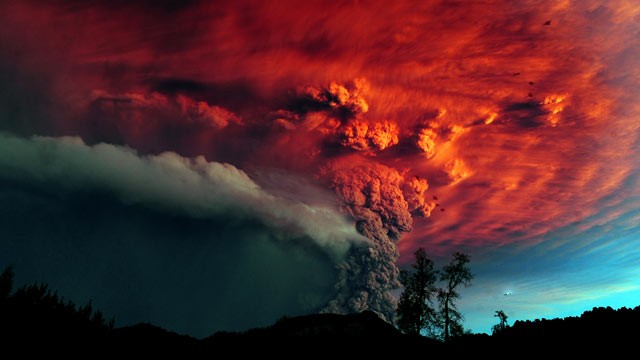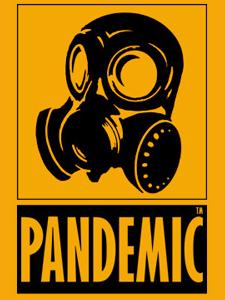Tag Archives: National
SuperVolcanoes – This Is the Way the World Ends? Volcanoes Could Darken World

Super-volcanoes have probably caused more extinctions than asteroids. But until now it has been thought that these giant volcanoes took thousands of years to form — and would remain trapped beneath the earth’s crust for thousands more years — before having much effect on the planet.
But new research indicates these catastrophic eruptions, possibly thousands of times more powerful than the 1980 eruption of Mount St. Helens, may happen only a few hundred years after the volcanoes form. In other words, they may have a very “short fuse,” according to researchers at Vanderbilt University.
Such an event could make thermonuclear war or global warming seem trivial, spewing untold tons of ash into the atmosphere to block sunlight. The result would be many years of frigid temperatures, wiping out millions of species. A super-volcano that erupted 250 million years ago is now believed to have created the greatest mass extinction the world has ever seen, wiping out up to 95 percent of all plant and animal species. Some renegade scientists believe it was a volcano, not an asteroid, that killed off the dinosaurs 65 million years ago.
But is global suicide lurking right below our feet? Is a super-volcano about to blow its top? Not as far as scientists can tell. Such a volcano results from the accumulation of a giant pool of lava just a few miles below the ground, and there is no known formation anywhere on the planet that is expected to erupt in the immediate future.
Scientists, who could be wrong about that, have thought for decades that once that pool forms, it stays there for thousands of years before erupting. But the new study by geophysicists from Vanderbilt, along with colleagues at the University of Chicago and elsewhere, documents several lines of research showing that the trigger could be pulled quickly, possibly within a few hundred years.
“Our study suggests that when these exceptionally large magma pools form they are ephemeral and cannot exist very long without erupting,” Vanderbilt’s Guilherme Gualda said in releasing the study, published in the journal Public Library of Science ONE.
That research, as well as earlier research that led to a very different conclusion, was based on the formation of crystals in the molten magma that decay at known rates and thus provide a geological clock, dating various events in the history of the volcano.
According to Gualda, previous researchers looked at the decay of zircons, which are common in volcanic rocks, and concluded that the giant magma pools could exist for 100,000 years. But his team looked at the crystallization of quartz, the most abundant mineral in volcanic deposits, and concluded that such a pool would have to erupt in one-tenth of that time, and possibly in only about 500 years.
That makes the threat of super-volcanoes a bit more serious, but there’s no reason to panic.
Gualda’s team studied deposits in the Long Valley Caldera in northeastern California, where a violent eruption blew 150 cubic miles of molten rock into the atmosphere, blanketing much of North America with hot ash and dropping the earth’s surface more than a mile as it sank into the area once occupied by the magma. That was about 760,000 years ago, but all these years later the region still keeps a lot of scientists on the edge of their seats.
The Long Valley geology began misbehaving again in 1978 when a 5.4 earthquake struck six miles southeast of the caldera, suggesting that the volcano might be reasserting itself. In subsequent years that was followed by swarms of small quakes, which are closely associated with pending volcanic eruptions.
A couple of decades ago, trees began dying on nearby Mammoth Mountain from large amounts of carbon dioxide seeping from the magma, according to the U.S. Geological Survey.
Today, the caldera seems to be quieting down, despite several recent bursts of seismic events, but it is probably the most closely watched volcano on the planet. Scientists with the USGS are keeping a close eye on it, monitoring every little belch, and they insist there is no reason for the folks who live in California to be concerned. At least not yet.
Meanwhile, scientists at Oregon State University have been focusing their attention on Yellowstone National Park, where an eruption a couple of million years ago is believed to have been 2,000 times larger than Mount St. Helens. That region also shows constant signs of seismic unrest, and there have been eruptions there several times in the past, according to the Oregon researchers.
Incidentally, researchers at Washington State University in Pullman, who have also been studying Yellowstone, concluded earlier this year that the big eruption 2 million years ago wasn’t one blast, but two, separated by about 6,000 years.
But just because it was split into two parts doesn’t mean it was benign. The Washington researchers believe the first blast was the biggest, and it darkened the sky with ash from California to the Mississippi River.
So super-volcanoes cannot be ignored, and now it seems they can pull the trigger much more quickly than anyone had thought.
Zombie apocalypse prophesied in ancient scriptures
 In recent headlines, there have been outbreaks of bizarre, brutal, cannibalistic events that have unfolded over the past few weeks, with an almost daily occurrence of articles written about cannibalism and the “Zombie Apocalypse.” There have been disturbing tales of humans devouring fellow humans, from the bath salts incident, involving a nakedcannibal, to the ‘Cannibal Killer,’ a porn star who allegedly murdered, dismembered and tasted the flesh of his victim. Just Saturday, many newspapers even reported the stomach contents of the Miami cannibal/zombie. Stores are beginning to carry zombie bullets, and college dorms are beginning to hold zombie drills, so students will be prepared for the hoards of zombies that could possibly attack mankind. Unfortunately, all of these stories seem perfectly suited to for horror films, but are real.
In recent headlines, there have been outbreaks of bizarre, brutal, cannibalistic events that have unfolded over the past few weeks, with an almost daily occurrence of articles written about cannibalism and the “Zombie Apocalypse.” There have been disturbing tales of humans devouring fellow humans, from the bath salts incident, involving a nakedcannibal, to the ‘Cannibal Killer,’ a porn star who allegedly murdered, dismembered and tasted the flesh of his victim. Just Saturday, many newspapers even reported the stomach contents of the Miami cannibal/zombie. Stores are beginning to carry zombie bullets, and college dorms are beginning to hold zombie drills, so students will be prepared for the hoards of zombies that could possibly attack mankind. Unfortunately, all of these stories seem perfectly suited to for horror films, but are real.
Incredibly, though the prospect of zombies and a zombie apocalypse seem purely fiction in the minds of most, the ancient scriptures reveal past, and possibly, future events that significantly resemble zombies or the walking undead. Take for example the death and resurrection narrative of Jesus of Nazareth, though no one would suggest Jesus was a zombie, a portion of the narrative surrounding his death, reveals an incident that most people overlook.
Matt. 27:50-53: And Jesus cried out again with a loud voice, and yielded up His spirit. And behold, the veil of the temple was torn in two from top to bottom; and the earth shook and the rocks were split. The tombs were opened, and many bodies of the saints who had fallen asleep were raised; and coming out of the tombs after His resurrection they entered the holy city and appeared to many.
One could not even imagine what it would have been like to see all of the past saints walk out of their graves, and appear to those dwelling in Jerusalem. Furthermore, one might ask, what actually happened to the bodies of those who were raised? Are they still among us? Or did they die a second time?
A second past event, found within the ancient scriptures, can be found in Ezekiel 37.
Ezekiel 37:7-10: So I prophesied as I was commanded. And as I was prophesying, there was a noise, a rattling sound, and the bones came together, bone to bone. I looked, and tendons and flesh appeared on them and skin covered them…and breath entered them; they came to life and stood up on their feet—a vast army.
Future Zombie Apocalypse
According to certain Christian eschatology, there are two future events that could resemble a zombie apocalypse. The first event, familiar to most, is the resurrection of the dead, in the “last days.” This event is viewed by most, as a time when all the graves of mankind will open, and everyone who has died will come forth for the “final judgment.” In fact, many believe that the dead will be the first judged at the final judgment, and those who are living will witness the event, previous to their judgment. Thus, those who are alive will first witness the dead arising from their graves.
1 Corinthians 15:51- 52: Behold, I shew you a mystery; We shall not all sleep, but we shall all be changed, in a moment, in the twinkling of an eye, at the last trump: for the trumpet shall sound, and the dead shall be raised incorruptible, and we shall be changed.
John 5:28-29: Marvel not at this: for the hour is coming, in the which all that are in the graves shall hear his voice, and shall come forth; they that have done good, unto the resurrection of life; and they that have done evil, unto the resurrection of damnation.
The second eschatological or future event, which could be viewed as a zombie apocalypse, is known by most as the “battle of Armageddon.” It is believed that in the final days, the armies of the devil or Satan, will rise up against God, Israel and God’s army, at a place known as Armageddon. When this occurs, it will appear as if evil has won, throughout the entire earth. At that point, most believe that Jesus will return with all the armies of heaven, to finally defeat the devil and his armies, and cast them into the “lake of fire.”
Revelation 16:12-16 For they are the spirits of devils, working miracles, which go forth unto the kings of the earth and of the whole world, to gather them to the battle of that great day of God Almighty… And he gathered them together into a place called in the Hebrew tongue Armageddon.
Revelation 19:19 And I saw the beast, and the kings of the earth, and their armies, gathered together to make war against him that sat on the horse, and against his army.
Now, there are many scriptures that Christians, which hold this view, use as proof of a future battle. However, one scriptural source, which most have not thoroughly considered, could appear as a massive zombie attack.
Zechariah 14:12-13 And the LORD will send a plague on all the nations that fought against Jerusalem. Their people will become like walking corpses, their flesh rotting away. Their eyes will rot in their sockets, and their tongues will rot in their mouths. On that day they will be terrified, stricken by the LORD with great panic. They will fight their neighbors hand to hand.
Today, most zombie lore revolves around plagues, which cause the dead to rise, and typically battle with or eat the living. This scripture in Zechariah seems to clearly reveal an event, similar to the most recent zombie lore. One might wonder if ancient Christians also feared and imminent zombie attack as well. At the very least, zombie apocalypse fanatics now have a further argument in their arsenal, which points toward a future attack of the undead, found within the ancient scriptures.
 said the country was not ready to defend itself against an avian flu pandemic. Have things changed since?
said the country was not ready to defend itself against an avian flu pandemic. Have things changed since?